The faces of chronic pain in the veterinary clinic
The last thing you want is to allow a pet to experience or subsist in pain. Take a trip through this photo gallery to make sure your pain detector is set on high and ready to take action.
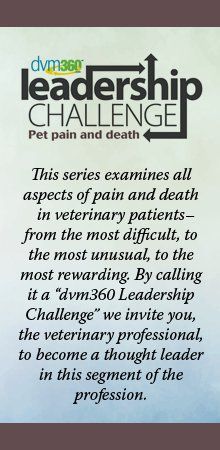
Click on the image above for more on pain and death.With so many options now at your disposal to take the pain away or prevent it in the first place in veterinary patients, paying more attention to where you or your clients might be missing it is a vital exercise. We worked with Robin Downing, DVM, MS, DAAPM, DACVSMR, CVPP, CCRP, on a photo gallery of pets in chronic pain to give you a visual guide to brush up your recognition.
The grimace of a hero
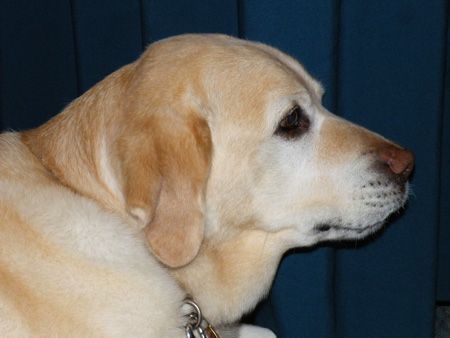
(All photos courtesy of Dr. Robin Downing)This dog, Roselle, is a life-saver. She was the guide dog of Michael Hingson, a man who was blind and caught in one of the twin towers during the 9/11 attack. Roselle led Hingson and others to safety through a smoke-filled staircase. You can read about it in Thunder Dog. Dr. Downing met Roselle and Hingson many years later when Hingson was a keynote speaker at a veterinary conference, and she noticed something about Roselle-she was in pain. In this photo that Dr. Downing took of Roselle at the event, note that that her ears are a little bit forward and she is grimacing. How can you tell? Dr. Downing says the edge of Roselle's mouth should align with the outer edge of the eye, and hers doesn't. She is pursing her lips because she is preoccupied with pain from osteoarthritis. Dr. Downing talked with Hingson and his wife about Roselle's signs of pain and told them to have their veterinarian call her so she could help Roselle be comfortable as she was about to enter her retirement. Roselle's veterinarian did work with Dr. Downing, and Roselle retired in contentment. In fact, Dr. Downing saw Roselle at another conference a few years later and she looked completely different-relaxed and happy, as a hero should be.
The pain of malignancy
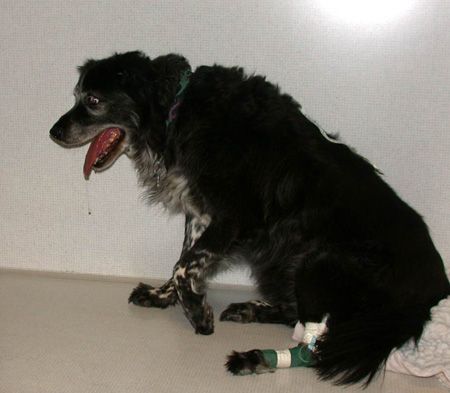
Spooky's chronic pain is caused by a malignant tumor. Note his raised paw and panting-not a comfortable dog. To ease Spooky's distress, the catheter placed in his rear leg will deliver not only his chemotherapy but also intravenous pain medication to get him back to being comfortable. (Photo courtesy of a colleague of Dr. Downing)
The fine art of feeling


This majestic Maine coon, Otis, was one of Dr. Downing's cats who had osteoarthritis. She palpated him on a regular basis, as pictured here, assessing for evidence of pain in his hindquarters. He lived until almost 19 years of age and eventually did need some pain medication later in his life, supplemented by chiropractic treatment and acupuncture.
A true transformative tale
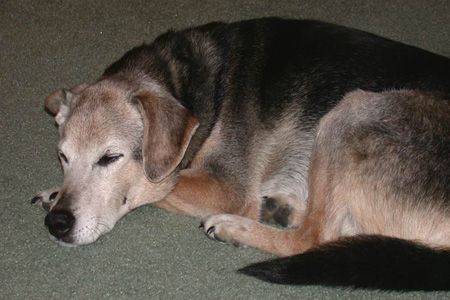
The owner of this dog had no idea that the reason her dog was wandering the house at night was because she could not get comfortable-her dog was in pain due to osteoarthritis. Dr. Downing and her crew used a pain management protocol to get this dog's pain score to 1 to 2 out of 10. The owners' response: Tears with the proclamation, “I had no idea. You've changed her life. She sleeps through the night now.” Dr. Downing says this lack of knowledge about signs of pain in pets is extremely common.
Misery loves company
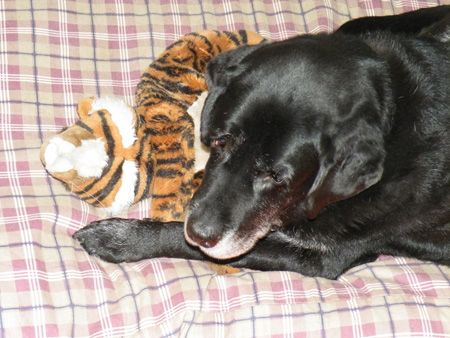
In this photo, Dr. Downing says Rascal is clutching his favorite toy, Tigger. His worried face reflects his overall discomfort. Rascal had severe osteoarthritis in his elbows and hips, as well as osteoarthritis in several areas along his spine. His mobility was severely limited, and he had lost interest in his activities of daily living. His family was worried that they should consider euthanasia. After Dr. Downing implemented a pain management program that included physical therapy, Rascal's pain was controlled, and he was able to relax with Tigger and enjoy a dog's life.
Pinning down the cause of pain


Dr. Downing and her team started treating Kitty the cat for chronic pain when she was 13 years old. With the help of acupuncture, as pictured, as well as laser and chiropractic treatments, Kitty lived to 21 years of age without the need for pain medication.
Two wheels to the rescue
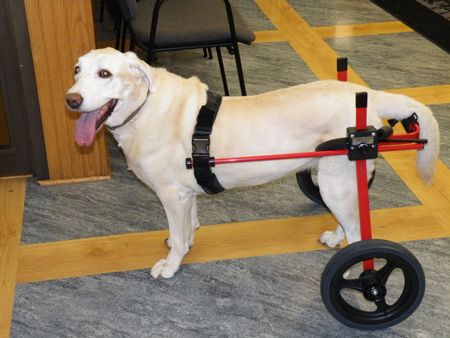
Before Chomo was fitted with a walking wheelchair, her degenerative myelopathy had progressed to the point that she had to overuse her front legs because her rear legs were almost unusable. This forelimb overusage caused pain, and Dr. Downing and her team realized she just needed some support. Thus, the wheelchair. As Chomo's limbs continued to lose function as she aged, slings were added to the wheelchair to hold her rear legs so she could still go for walks with her family. She ended up dying of end-stage kidney failure, completely unrelated to her debilitation.
Going through the motions is a good thing

In this photo, Dr. Downing shows how to mobilize or manipulate a dog's shoulder joint to help restore function and reduce pain. She uses this pain management modality for dogs with chronic pain such a calcification of a tendon in the shoulder joint. The calcification shortens the tendon, making movement painful. Range-of-motion exercises restore the shoulder to full mobility.
A royal's treatment

Princess, pictured above, is now pain-free, but she was not so fortunate earlier in life. She had ruptured a disk and was completely paralyzed when she was found abandoned. Dr. Downing encountered her at an adoption event, and she was a miserable mutt. “She was caked in dried-up urine. She had a terrible urinary tract infection. She had stool in her hair,” says Dr. Downing. The foster home she was in had tried to help her, but it wasn't enough-in fact her pain score was an 8 or a 9 out of 10 because of pulling along her unresponsive rear end. Dr. Downing took her under her wing, cleaning up her coat and her infections. And Princess was in luck-she was a good spinal walker, which is where the spinal cord kicks in and takes over imitating a walk with the rear legs pumping up and down, bypassing the inattentive brain. Princess was such a good spinal walker that a cart was not needed. Instead Dr. Downing and her team used an underwater treadmill for neuromuscular memory training, making her natural spinal walking skills shine even more brilliantly. After six months of Dr. Downing's care, Princess found a good home where she remains pain-free and a supreme spinal walker.
Strength and balance

The owners of Boyd, a 15-year-old cat with osteoarthritis in his lower back and hips, first noticed changes in his behavior such as not jumping to the window to watch the birds outside. He had lost muscle strength and coordination because of this inability to jump and play as he used to. And, as Dr. Downing says, “With muscles, it's use them or lose them, so he lost them.” As part of his physical therapy, Dr. Downing used laser therapy and, as pictured above, balance work to restore his muscle strength. In addition, he was one of a handful of cats she has treated in an underwater treadmill, as pictured below. “He would walk for 30 minutes, which helped improve his mobility.” Boyd lived happily and healthily until 18 years of age.

Shiloh's battle

Although spondylosis does not cause pain in and of itself, it's a good sign a pet is in pain, says Dr. Downing. This was the case with Shiloh. She had bridging spondylosis almost the entire length of her spine, resulting in restricted mobility and pain-misery in fact. “She's the only pet I've ever scored that had a pain score of 9 out of 10 that was still walking around,” says Dr. Downing. Her owner brought her to Dr. Downing for euthanasia-she couldn't bear to be touched and tried to bite Dr. Downing as she fell to the floor. But in stepped the miracle of physical therapy, in conjunction with pain medication. And this is important, says Dr. Downing-the correct order is to control pain and then restore function, not the other way around. “There are people doing physical therapy on dogs who are not doing a very good job on the pain piece. They're subjecting animals to physical therapy techniques, and they can't understand why the dog is not thrilled about it. They are miserable. You have to break the pain cycle first,” she says. Because Shiloh's pain was controlled and she was able to improve her mobility with the help of physical therapy, this dog who was brought in for euthanasia was able to spend two more years with her family.
It's the little things

This dog had lost a ligament in her ankle, and since she was such a small dog, the surgeon that Dr. Downing consulted with thought she might be a good candidate for a brace. The brace worked and the dog was able to strut her miniature but mighty stuff without any problems, showing the promise of assistive devices in some patients.
Electrical effects

Another one of Dr. Downing's pets makes an appearance in this photo. Her Saint Bernard Molly had degenerative myelopathy, which was diagnosed at the age of 11. Along with other pain control measures, Dr. Downing used electrical impulses delivered through acupuncture needles to help. She died when she was 14 years old, a very ripe old age for a Saint Bernard. Dr. Downing commonly uses electrical pulses with acupuncture in pets with chronic pain. An example protocol for this modality: treat two to three times a week for two weeks, then once a week for two weeks and then determine if the patient will benefit from maintenance therapy, coming in anywhere from every two to six weeks for a “tune up.” Between treatments, Dr. Downing uses other forms of pain control. When she chooses this modality, “I do prepare owners for the possibility that we'll see their pets on a regular basis,” she says.
The poster child of pain prevention
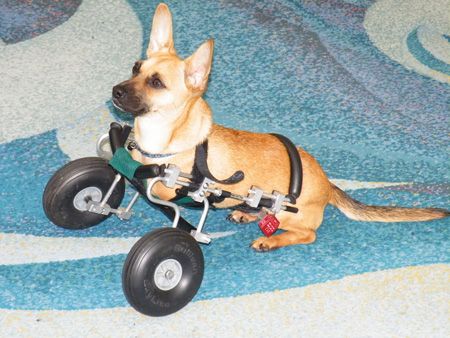
Being born without front legs can be a death sentence or a life of excruciating pain for a dog. But when Dr. Downing came upon this lucky dog at a veterinary convention, she had to snap a picture when she heard his story. When he was first born, he scooted around well on his back legs, but the person who adopted him realized he would get along even better with a set of wheels. His owner straps him into his wheelchair in the morning, and he's off for a normal doggie day. The consummate pain prevention advocate, Dr. Downing did a little investigating herself as she talked with the owner: “I can ferret out pain where I can find it, and I was petting and palpating the dog and he had no pain. He was really comfortable.” Chronic pain prevention in action, thanks to a set of wheels and an astute owner.